Suvorexant
Editor-In-Chief: C. Michael Gibson, M.S., M.D. [1]; Associate Editor(s)-in-Chief: Turky Alkathery, M.D. [2]
Disclaimer
WikiDoc MAKES NO GUARANTEE OF VALIDITY. WikiDoc is not a professional health care provider, nor is it a suitable replacement for a licensed healthcare provider. WikiDoc is intended to be an educational tool, not a tool for any form of healthcare delivery. The educational content on WikiDoc drug pages is based upon the FDA package insert, National Library of Medicine content and practice guidelines / consensus statements. WikiDoc does not promote the administration of any medication or device that is not consistent with its labeling. Please read our full disclaimer here.
Overview
Suvorexant is an orexin receptor antagonist that is FDA approved for the treatment of insomnia, characterized by difficulties with sleep onset and/or sleep maintenance. Common adverse reactions include somnolence.
Adult Indications and Dosage
FDA-Labeled Indications and Dosage (Adult)
Indications
- Suvorexant is indicated for the treatment of insomnia characterized by difficulties with sleep onset and/or sleep maintenance.
Dosage
Dosing Information
- Use the lowest dose effective for the patient.
- The recommended dose for suvorexant is 10 mg, taken no more than once per night and within 30 minutes of going to bed, with at least 7 hours remaining before the planned time of awakening. If the 10 mg dose is well-tolerated but not effective, the dose can be increased. The maximum recommended dose of suvorexant is 20 mg once daily.
Special Populations
- Exposure to suvorexant is increased in obese compared to non-obese patients, and in women compared to men. Particularly in obese women, the increased risk of exposure-related adverse effects should be considered before increasing the dose.
Use with CNS Depressants
- When suvorexant is combined with other CNS depressant drugs, dosage adjustment of suvorexant and/or the other drug(s) may be necessary because of potentially additive effects.
Use with CYP3A Inhibitors
- The recommended dose of suvorexant is 5 mg when used with moderate CYP3A inhibitors and the dose generally should not exceed 10 mg in these patients. Suvorexant is not recommended for use with strong CYP3A inhibitors.
Food Effect
- Time to effect of suvorexant may be delayed if taken with or soon after a meal.
Off-Label Use and Dosage (Adult)
Guideline-Supported Use
- There is limited information regarding Off-Label Guideline-Supported Use of Suvorexant in adult patients.
Non–Guideline-Supported Use
- There is limited information regarding Off-Label Non–Guideline-Supported Use of Suvorexant in adult patients.
Pediatric Indications and Dosage
FDA-Labeled Indications and Dosage (Pediatric)
- Safety and effectiveness in pediatric patients have not been established.
Off-Label Use and Dosage (Pediatric)
Guideline-Supported Use
There is limited information regarding Off-Label Guideline-Supported Use of Suvorexant in pediatric patients.
Non–Guideline-Supported Use
There is limited information regarding Off-Label Non–Guideline-Supported Use of Suvorexant in pediatric patients.
Contraindications
- Suvorexant is contraindicated in patients with narcolepsy.
Warnings
CNS Depressant Effects and Daytime Impairment
- Suvorexant is a central nervous system (CNS) depressant that can impair daytime wakefulness even when used as prescribed. Prescribers should monitor for somnolence and CNS depressant effects, but impairment can occur in the absence of symptoms, and may not be reliably detected by ordinary clinical exam (i.e., less than formal testing of daytime wakefulness and/or psychomotor performance). CNS depressant effects may persist in some patients for up to several days after discontinuing suvorexant.
- Suvorexant can impair driving skills and may increase the risk of falling asleep while driving. Discontinue or decrease the dose in patients who drive if daytime somnolence develops. In a study of healthy adults, driving ability was impaired in some individuals taking 20 mg suvorexant. Although pharmacodynamic tolerance or adaptation to some adverse depressant effects of suvorexant may develop with daily use, patients using the 20 mg dose of suvorexant should be cautioned against next-day driving and other activities requiring full mental alertness. Patients taking lower doses of suvorexant should also be cautioned about the potential for driving impairment because there is individual variation in sensitivity to suvorexant.
- Co-administration with other CNS depressants (e.g., benzodiazepines, opioids, tricyclic antidepressants, alcohol) increases the risk of CNS depression. Patients should be advised not to consume alcohol in combination with suvorexant because of additive effects. Dosage adjustments of suvorexant and of concomitant CNS depressants may be necessary when administered together because of potentially additive effects. The use of suvorexant with other drugs to treat insomnia is not recommended.
- The risk of next-day impairment, including impaired driving, is increased if suvorexant is taken with less than a full night of sleep remaining, if a higher than the recommended dose is taken, if co-administered with other CNS depressants, or if co-administered with other drugs that increase blood levels of suvorexant. Patients should be cautioned against driving and other activities requiring complete mental alertness if suvorexant is taken in these circumstances.
Need to Evaluate for Co-morbid Diagnoses
- Because sleep disturbances may be the presenting manifestation of a physical and/or psychiatric disorder, treatment of insomnia should be initiated only after careful evaluation of the patient. The failure of insomnia to remit after 7 to 10 days of treatment may indicate the presence of a primary psychiatric and/or medical illness that should be evaluated. Worsening of insomnia or the emergence of new cognitive or behavioral abnormalities may be the result of an unrecognized underlying psychiatric or physical disorder, and can emerge during the course of treatment with hypnotic drugs such as suvorexant.
Abnormal Thinking and Behavioral Changes
- A variety of cognitive and behavioral changes (e.g., amnesia, anxiety, hallucinations and other neuro-psychiatric symptoms) have been reported to occur in association with the use of hypnotics such as suvorexant. Complex behaviors such as "sleep-driving" (i.e., driving while not fully awake after taking a hypnotic) and other complex behaviors (e.g., preparing and eating food, making phone calls, or having sex), with amnesia for the event, have been reported in association with the use of hypnotics. These events can occur in hypnotic-naïve as well as in hypnotic-experienced persons. The use of alcohol and other CNS depressants may increase the risk of such behaviors. Discontinuation of suvorexant should be strongly considered for patients who report any complex sleep behavior.
Worsening of Depression/Suicidal Ideation
- In clinical studies, a dose-dependent increase in suicidal ideation was observed in patients taking suvorexant as assessed by questionnaire. Immediately evaluate patients with suicidal ideation or any new behavioral sign or symptom.
- In primarily depressed patients treated with sedative-hypnotics, worsening of depression, and suicidal thoughts and actions (including completed suicides) have been reported. Suicidal tendencies may be present in such patients and protective measures may be required. Intentional overdose is more common in this group of patients; therefore, the lowest number of tablets that is feasible should be prescribed for the patient at any one time.
- The emergence of any new behavioral sign or symptom of concern requires careful and immediate evaluation.
Patients with Compromised Respiratory Function
- Effect of suvorexant on respiratory function should be considered if prescribed to patients with compromised respiratory function. Suvorexant has not been studied in patients with severe obstructive sleep apnea (OSA) or severe chronic obstructive pulmonary disease (COPD).
Sleep Paralysis, Hypnagogic/Hypnopompic Hallucinations, Cataplexy-like Symptoms
- Sleep paralysis, an inability to move or speak for up to several minutes during sleep-wake transitions, and hypnagogic/hypnopompic hallucinations, including vivid and disturbing perceptions by the patient, can occur with the use of suvorexant. Prescribers should explain the nature of these events to patients when prescribing suvorexant.
- Symptoms similar to mild cataplexy can occur, with risk increasing with the dose of suvorexant. Such symptoms can include periods of leg weakness lasting from seconds to a few minutes, can occur both at night and during the day, and may not be associated with an identified triggering event (e.g., laughter or surprise).
Adverse Reactions
Clinical Trials Experience
- Because clinical trials are conducted under widely varying conditions, adverse reaction rates observed in the clinical trials of a drug cannot be directly compared to rates in the clinical trials of another drug and may not reflect the rates observed in clinical practice.
- In 3-month controlled efficacy trials (Study 1 and Study 2), 1263 patients were exposed to suvorexant including 493 patients who received suvorexant 15 mg or 20 mg (see TABLE 1).
- In a long-term study, additional patients (n=521) were treated with suvorexant at higher than recommended doses, including a total of 160 patients who received suvorexant for at least one year.
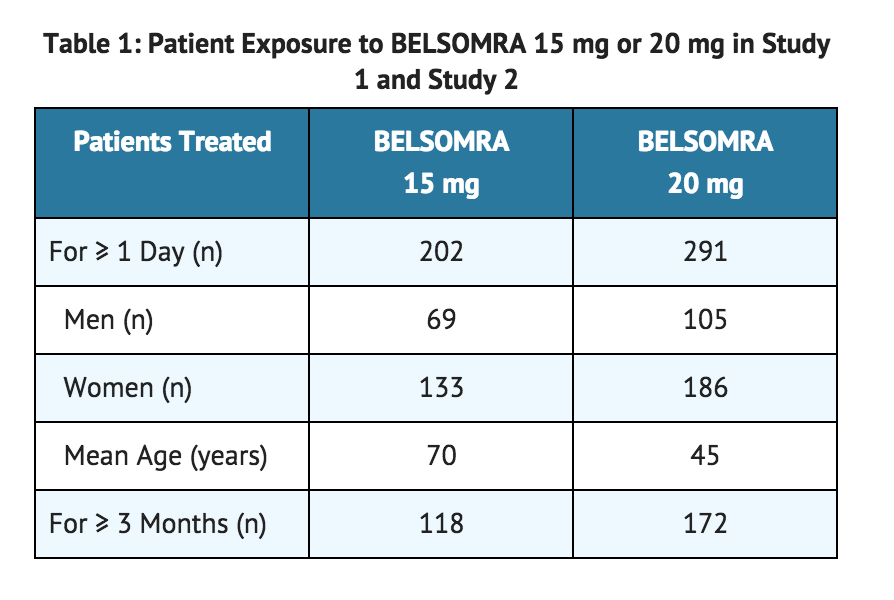
The pooled safety data described below (see TABLE 2) reflect the adverse reaction profile during the first 3 months of treatment.
Adverse Reactions Resulting in Discontinuation of Treatment
- The incidence of discontinuation due to adverse reactions for patients treated with 15 mg or 20 mg of suvorexant was 3% compared to 5% for placebo. No individual adverse reaction led to discontinuation at an incidence ≥1%.
Most Common Adverse Reactions
- In clinical trials of patients with insomnia treated with suvorexant 15 mg or 20 mg, the most common adverse reaction (reported in 5% or more of patients treated with suvorexant and at least twice the placebo rate) was somnolence (suvorexant 7%; placebo 3%).
- Table 2 shows the percentage of patients with adverse reactions during the first three months of treatment, based on the pooled data from 3-month controlled efficacy trials (Study 1 and Study 2).
- At doses of 15 or 20 mg, the incidence of somnolence was higher in females (8%) than in males (3%). Of the adverse reactions reported in Table 2, the following occurred in women at an incidence of at least twice that in men: headache, abnormal dreams, dry mouth, cough, and upper respiratory tract infection.
- The adverse reaction profile in elderly patients was generally consistent with non-elderly patients. The adverse reactions reported during long-term treatment up to 1 year were generally consistent with those observed during the first 3 months of treatment.
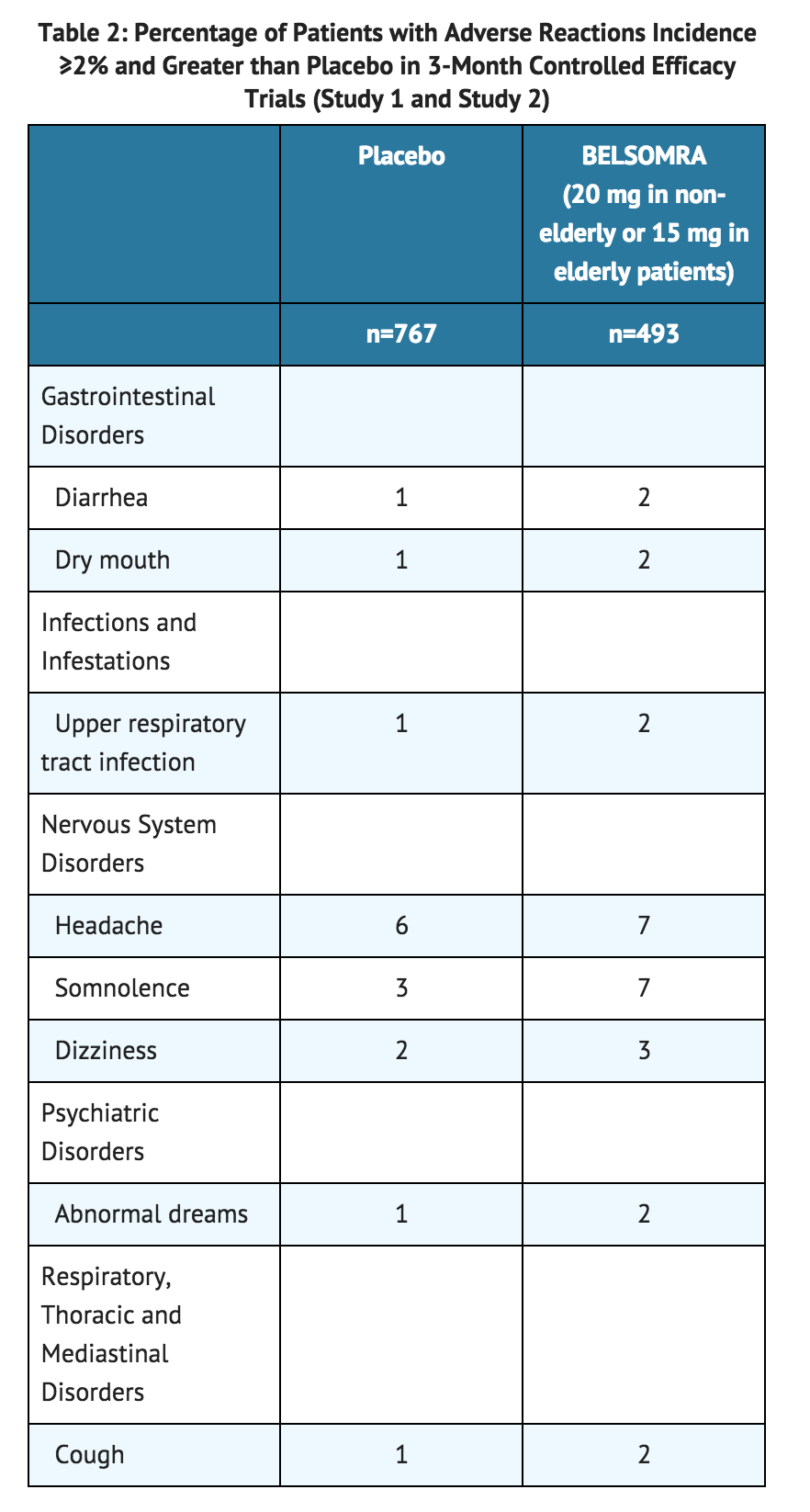
Dose Relationship for Adverse Reactions
- There is evidence of a dose relationship for many of the adverse reactions associated with suvorexant use, particularly for certain CNS adverse reactions.
- In a placebo-controlled crossover study (Study 3), non-elderly adult patients were treated for up to one month with suvorexant at doses of 10 mg, 20 mg, 40 mg (2 times the maximum recommended dose) or 80 mg (4 times the maximum recommended dose). In patients treated with suvorexant 10 mg (n=62), although no adverse reactions were reported at an incidence of ≥2%, the types of adverse reactions observed were similar to those observed in patients treated with suvorexant 20 mg. suvorexant was associated with a dose-related increase in somnolence: 2% at the 10 mg dose, 5% at the 20 mg dose, 12% at the 40 mg dose, and 11% at the 80 mg dose, compared to <1% for placebo. suvorexant was also associated with a dose-related increase in serum cholesterol: 1 mg/dL at the 10 mg dose, 2 mg/dL at the 20 mg dose, 3 mg/dL at the 40 mg dose, and 6 mg/dL at the 80 mg dose after 4 weeks of treatment, compared to a 4 mg/dL decrease for placebo.
Postmarketing Experience
- There is limited information regarding postmarketing experience.
Drug Interactions
CNS-Active Agents
- When suvorexant was co-administered with alcohol, additive psychomotor impairment was demonstrated. There was no alteration in the pharmacokinetics of suvorexant .
Effects of Other Drugs on Suvorexant
- Metabolism by CYP3A is the major elimination pathway for suvorexant.
- CYP3A Inhibitors
- Concomitant use of suvorexant with strong inhibitors of CYP3A (e.g., ketoconazole, itraconazole, posaconazole, clarithromycin, nefazodone, ritonavir, saquinavir, nelfinavir, indinavir, boceprevir, telaprevir, telithromycin and conivaptan) is not recommended.
- The recommended dose of suvorexant is 5 mg in subjects receiving moderate CYP3A inhibitors (e.g., amprenavir, aprepitant, atazanavir, ciprofloxacin, diltiazem, erythromycin, fluconazole, fosamprenavir, grapefruit juice, imatinib, verapamil). The dose can be increased to 10 mg in these patients if necessary for efficacy.
- CYP3A Inducers
- Suvorexant exposure can be substantially decreased when co-administered with strong CYP3A inducers (e.g., rifampin, carbamazepine and phenytoin). The efficacy of suvorexant may be reduced.
Effects of Suvorexant on Other Drugs
- Digoxin
- Concomitant administration of suvorexant with digoxin slightly increased digoxin levels due to inhibition of intestinal P-gp. Digoxin concentrations should be monitored when co-administering suvorexant with digoxin.
Use in Specific Populations
Pregnancy
- There are no adequate and well-controlled studies in pregnant women. Suvorexant should be used during pregnancy only if the potential benefit justifies the potential risk to the fetus. Administration of suvorexant to pregnant rats throughout organogenesis in two separate studies at oral doses of 30, 150, and 1000 mg/kg or 30, 80, and 325 mg/kg resulted in a decrease in fetal body weight at doses greater than 80 mg/kg. Plasma exposures (AUC) at the no-effect dose were approximately 25 times that in humans at the maximum recommended human dose (MRHD) of 20 mg/day.
- Administration of suvorexant to pregnant rabbits throughout organogenesis in two separate studies at oral doses of 40, 100, and 300 mg/kg or 50, 150, and 325 mg/kg resulted in no apparent adverse effects on embryo-fetal development. Excessive toxicity resulted in premature sacrifice of pregnant animals at 325 mg/kg. The highest maternal plasma exposures (AUC) for which there are fetal data were up to approximately 40 times that in humans at the MRHD.
- Administration of suvorexant (oral doses of 30, 80, and 200 mg/kg) to pregnant rats throughout gestation and lactation resulted in decreased body weight in offspring at the highest dose tested. Plasma AUCs at the no-effect dose were approximately 25 times that in humans at the MRHD.
Pregnancy Category (AUS):
There is no Australian Drug Evaluation Committee (ADEC) guidance on usage of Suvorexant in women who are pregnant.
Labor and Delivery
There is no FDA guidance on use of Suvorexant during labor and delivery.
Nursing Mothers
- Suvorexant and a hydroxyl-suvorexant metabolite were excreted in rat milk at levels higher (9 and 1.5 times, respectively) than that in maternal plasma. It is not known whether this drug is secreted in human milk. Because many drugs are excreted in human milk, caution should be exercised when suvorexant is administered to a nursing woman.
Pediatric Use
- Safety and effectiveness in pediatric patients have not been established.
Geriatic Use
- Of the total number of patients treated with suvorexant (n=1784) in controlled clinical safety and efficacy studies, 829 patients were 65 years and over, and 159 patients were 75 years and over. No clinically meaningful differences in safety or effectiveness were observed between these patients and younger patients at the recommended doses.
Gender
There is no FDA guidance on the use of Suvorexant with respect to specific gender populations.
Race
There is no FDA guidance on the use of Suvorexant with respect to specific racial populations.
Renal Impairment
- No dose adjustment is required in patients with renal impairment.
Hepatic Impairment
- No dose adjustment is required in patients with mild and moderate hepatic impairment. Suvorexant has not been studied in patients with severe hepatic impairment and is not recommended for these patients.
Females of Reproductive Potential and Males
There is no FDA guidance on the use of Suvorexant in women of reproductive potentials and males.
Immunocompromised Patients
There is no FDA guidance one the use of Suvorexant in patients who are immunocompromised.
Patients with Compromised Respiratory Function
- Effects of suvorexant on respiratory function should be considered if prescribed to patients with compromised respiratory function.
- Obstructive Sleep Apnea
- The respiratory depressant effect of suvorexant was evaluated after one night and after four consecutive nights of treatment in a randomized, placebo-controlled, 2-period crossover study in patients (n=26) with mild to moderate obstructive sleep apnea. Following once-daily doses of 40 mg, the mean Apnea/Hypopnea Index treatment difference (suvorexant – placebo) on Day 4 was 2.7 (90% CI: 0.22 to 5.09), but there was wide inter- and intra-individual variability such that clinically meaningful respiratory effects of suvorexant in obstructive sleep apnea cannot be excluded. Suvorexant has not been studied in patients with severe obstructive sleep apnea.
- Chronic Obstructive Pulmonary Disease
- The respiratory depressant effect of suvorexant was evaluated after one night and after four consecutive nights of treatment in a randomized, placebo-controlled, 2-period crossover study in patients (n=25) with mild to moderate chronic obstructive pulmonary disease (COPD). Suvorexant (40 mg in non-elderly, 30 mg in elderly) had no respiratory depressant effects in patients with mild to moderate COPD, as measured by oxygen saturation. There was wide inter- and intra-individual variability such that clinically meaningful respiratory effects of suvorexant in COPD cannot be excluded. Suvorexant has not been studied in patients with severe COPD.
Administration and Monitoring
Administration
- Oral.
Monitoring
- Prescribers should monitor for somnolence and CNS depressant effects.
- Digoxin concentrations should be monitored when co-administering suvorexant with digoxin.
- Vital signs should be monitored with general supportive measures in overdosage.
IV Compatibility
- There is limited information regarding IV Compatibility.
Overdosage
- There is limited premarketing clinical experience with an overdosage of suvorexant. In clinical pharmacology studies, healthy subjects who were administered morning doses of up to 240 mg of suvorexant showed dose-dependent increases in the frequency and duration of somnolence.
- General symptomatic and supportive measures should be used, along with immediate gastric lavage where appropriate. Intravenous fluids should be administered as needed. As in all cases of drug overdose, vital signs should be monitored and general supportive measures employed. The value of dialysis in the treatment of overdosage has not been determined. As suvorexant is highly protein-bound, hemodialysis is not expected to contribute to elimination of suvorexant.
- As with the management of all overdosage, the possibility of multiple drug ingestion should be considered. Consider contacting a poison control center for up-to-date information on the management of hypnotic drug product overdosage.
Pharmacology

| |
Suvorexant
| |
| Systematic (IUPAC) name | |
| [(7R)-4-(5-chloro-1,3-benzoxazol-2-yl)-7-methyl-1,4-diazepan-1-yl][5-methyl-2-(2H-1,2,3-triazol-2-yl)phenyl]methanone | |
| Identifiers | |
| CAS number | |
| ATC code | None |
| PubChem | |
| Chemical data | |
| Formula | Template:OrganicBox atomTemplate:OrganicBox atomTemplate:OrganicBoxTemplate:OrganicBoxTemplate:OrganicBoxTemplate:OrganicBoxTemplate:OrganicBox atomTemplate:OrganicBoxTemplate:OrganicBoxTemplate:OrganicBoxTemplate:OrganicBoxTemplate:OrganicBoxTemplate:OrganicBoxTemplate:OrganicBox atomTemplate:OrganicBoxTemplate:OrganicBox atomTemplate:OrganicBoxTemplate:OrganicBoxTemplate:OrganicBoxTemplate:OrganicBoxTemplate:OrganicBoxTemplate:OrganicBoxTemplate:OrganicBox |
| Mol. mass | 450.920 g/mol |
| SMILES | & |
| Pharmacokinetic data | |
| Bioavailability | 82% |
| Protein binding | Y |
| Metabolism | ? |
| Half life | 12 hrs |
| Excretion | ? |
| Therapeutic considerations | |
| Pregnancy cat. |
C(US) |
| Legal status | |
| Routes | oral |
Mechanism of Action
- The mechanism by which suvorexant exerts its therapeutic effect in insomnia is presumed to be through antagonism of orexin receptors. The orexin neuropeptide signaling system is a central promoter of wakefulness. Blocking the binding of wake-promoting neuropeptides orexin A and orexin B to receptors OX1R and OX2R is thought to suppress wake drive.
- Antagonism of orexin receptors may also underlie potential adverse effects such as signs of narcolepsy/cataplexy. Genetic mutations in the orexin system in animals result in hereditary narcolepsy; loss of orexin neurons has been reported in humans with narcolepsy.
Structure
- BELSOMRA tablets contain suvorexant, a highly selective antagonist for orexin receptors OX1R and OX2R.
- Suvorexant is described chemically as:
- [(7R)-4-(5-chloro-2-benzoxazolyl) hexahydro-7-methyl-1H-1,4-diazepin-1-yl][5-methyl-2-(2H-1,2,3-triazol-2-yl)phenyl]methanone
- Its empirical formula is C23H23ClN6O2 and the molecular weight is 450.92. Its structural formula is:
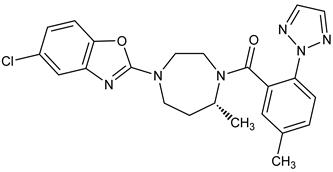
Suvorexant is a white to off-white powder that is insoluble in water.
- Each film coated tablet contains 5 mg, 10 mg, 15 mg, or 20 mg of suvorexant and the following inactive ingredients: polyvinylpyrrolidone/vinyl acetate copolymer (copovidone), microcrystalline cellulose, lactose monohydrate, croscarmellose sodium, and magnesium stearate.
- In addition, the film coating contains the following inactive ingredients: lactose monohydrate, hypromellose, titanium dioxide, and triacetin. The film coating for the 5 mg tablets also contains iron oxide yellow and iron oxide black, and the film coating for the 10 mg tablets also contains iron oxide yellow and FD&C Blue #1/Brilliant Blue FCF Aluminum Lake.
Pharmacodynamics
Evaluation of QTc Interval
- The effects of suvorexant on the QTc interval were evaluated in a randomized, placebo-, and active-controlled (moxifloxacin 400 mg) crossover study in healthy subjects (n=53). The upper bound of the one-sided 95% confidence interval for the largest placebo-adjusted, baseline-corrected QTc interval was below 10 ms based on analysis of suvorexant doses up to 240 mg, 12 times the maximum recommended dose. suvorexant thus does not prolong the QTc interval to any clinically relevant extent.
Pharmacokinetics
- Suvorexant exposure increases in a less than strictly dose-proportional manner over the range of 10-80 mg because of decreased absorption at higher doses. Suvorexant pharmacokinetics are similar in healthy subjects and patients with insomnia.
Absorption
- Suvorexant peak concentrations occur at a median Tmax of 2 hours (range 30 minutes to 6 hours) under fasted conditions. The mean absolute bioavailability of 10 mg is 82%.
- Ingestion of suvorexant with a high-fat meal resulted in no meaningful change in AUC or Cmax but a delay in Tmax of approximately 1.5 hours. Suvorexant may be taken with or without food; however for faster sleep onset, suvorexant should not be administered with or soon after a meal.
Distribution
- The mean volume of distribution of suvorexant is approximately 49 liters. Suvorexant is extensively bound (>99%) to human plasma proteins and does not preferentially distribute into red blood cells. Suvorexant binds to both human serum albumin and α1-acid glycoprotein.
Metabolism
- Suvorexant is mainly eliminated by metabolism, primarily by CYP3A with a minor contribution from CYP2C19. The major circulating entities are suvorexant and a hydroxy-suvorexant metabolite. This metabolite is not expected to be pharmacologically active.
Elimination
- The primary route of elimination is through the feces, with approximately 66% of radiolabeled dose recovered in the feces compared to 23% in the urine. The systemic pharmacokinetics of suvorexant are linear with an accumulation of approximately 1- to 2-fold with once-daily dosing. Steady-state is achieved by 3 days. The mean t1/2 is approximately 12 hours (95% CI: 12 to 13).
Special Populations
- Gender, age, body mass index (BMI), and race were included as factors assessed in the population pharmacokinetic model to evaluate suvorexant pharmacokinetics in healthy subjects and to predict exposures in the patient population. Age and race are not predicted to have any clinically meaningful changes on suvorexant pharmacokinetics; therefore, no dose adjustment is warranted based upon these factors.
- Suvorexant exposure is higher in females than in males. In females, the AUC and Cmax are increased by 17% and 9%, respectively, following administration of suvorexant 40 mg. The average concentration of suvorexant 9 hours after dosing is 5% higher for females across the dose range studied (10-40 mg). Dose adjustment of suvorexant is generally not needed based on gender only.
- Apparent oral clearance of suvorexant is inversely related to body mass index. In obese patients, the AUC and Cmax are increased by 31% and 17%, respectively. The average concentration of suvorexant approximately 9 hours after a 20 mg dose is 15% higher in obese patients (BMI > 30 kg/m2) relative to those with a normal BMI (BMI ≤ 25 kg/m2).
- In obese females, the AUC and Cmax are increased by 46% and 25%, respectively, compared to non-obese females. The higher exposure to suvorexant in obese females should be considered before increasing dose.
- The effects of renal and hepatic impairment on the pharmacokinetics of suvorexant were evaluated in specific pharmacokinetic studies.
- Suvorexant exposure after a single dose was similar in patients with moderate hepatic insufficiency (Child-Pugh category 7 to 9) and healthy matched control subjects; however, the suvorexant apparent terminal half-life was increased from approximately 15 hours (range 10 - 22 hours) in healthy subjects to approximately 19 hours (range 11 - 49 hours) in patients with moderate hepatic insufficiency.
- Suvorexant exposure (expressed as total and unbound concentrations) was similar between patients with severe renal impairment (urinary creatinine clearance ≤30 mL/min/1.73m2) and healthy matched control subjects. No dose adjustment is required in patients with renal impairment.
Drug Interactions
CNS-Active Drugs
- An additive effect on psychomotor performance was observed when a single dose of 40 mg of suvorexant was co-administered with a single dose of 0.7 g/kg alcohol. Suvorexant did not affect alcohol concentrations and alcohol did not affect suvorexant concentration.
- An interaction study with a single dose of 40 mg suvorexant and paroxetine 20 mg at steady-state levels in healthy subjects did not demonstrate a clinically significant pharmacokinetic or pharmacodynamic interaction.
Effects of Other Drugs on Suvorexant
- The effects of other drugs on the pharmacokinetics of suvorexant are presented in Figure 1 as change relative to suvorexant administered alone (test/reference). Strong (e.g., ketoconazole or itraconazole) and moderate (e.g., diltiazem) CYP3A inhibitors significantly increased suvorexant exposure. Strong CYP3A inducers (e.g., rifampin) substantially decreased suvorexant exposure.
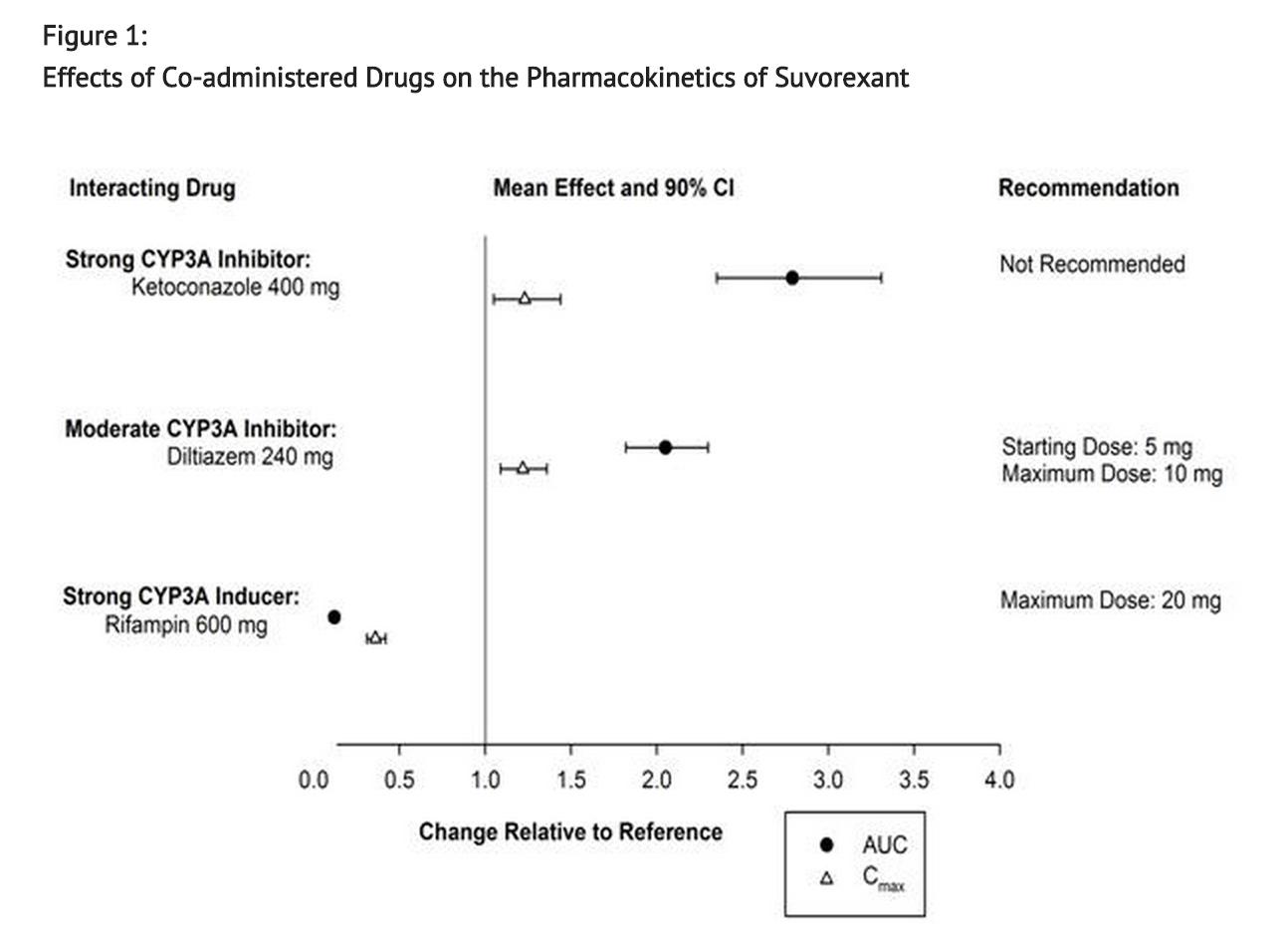
Effects of Suvorexant on Other Drugs
In vitro metabolism studies demonstrate that suvorexant has the potential to inhibit CYP3A and intestinal P-gp; however, suvorexant is unlikely to cause clinically significant inhibition of human CYP1A2, CYP2B6, CYP2C8, CYP2C9, CYP2C19 or CYP2D6. In addition, no clinically meaningful inhibition of OATP1B1, BCRP and OCT2 transporters is anticipated. Chronic administration of suvorexant is unlikely to induce the metabolism of drugs metabolized by major CYP isoforms. Specific in vivo effects on the pharmacokinetics of midazolam, warfarin, digoxin and oral contraceptives are presented in Figure 2 as a change relative to the interacting drug administered alone (test/reference).
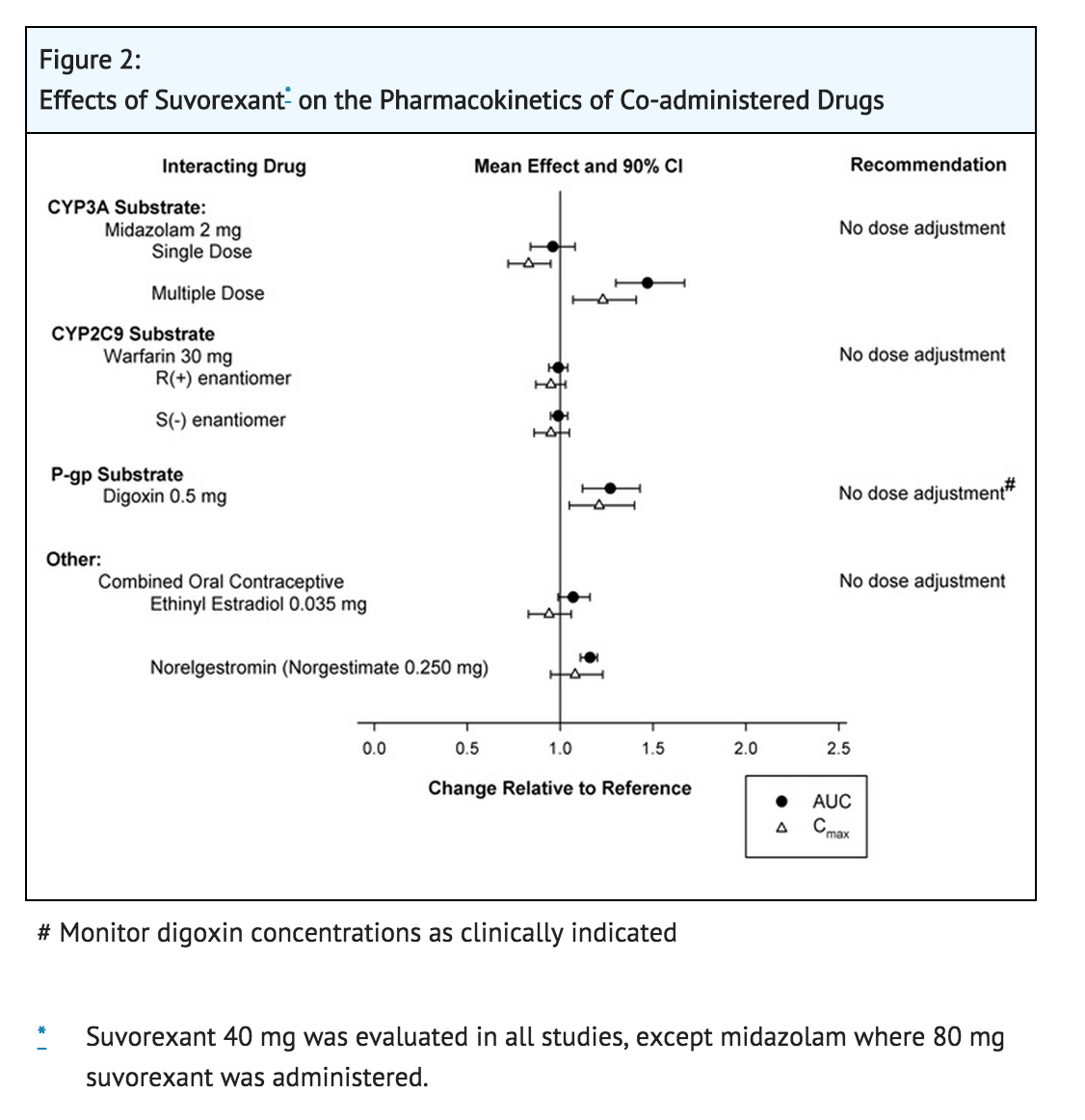
Nonclinical Toxicology
Carcinogenesis, Mutagenesis, Impairment of Fertility
Carcinogenesis
- In a 26-week study in Tg.rasH2 mice, there was no evidence of suvorexant-induced neoplasms at oral doses of 25, 50, 200, and 650 mg/kg/day.
- In a 2-year study in rats (oral suvorexant doses of 80, 160, and 325 mg/kg/day), increases in thyroid (follicular cell adenoma and combined adenoma/carcinoma in high-dose females; follicular cell adenoma in mid- and high-dose males) and liver (hepatocellular adenoma in high-dose males) neoplasms were observed. These findings were consistent with increased TSH and hepatic enzyme induction, respectively, which are mechanisms believed to be rodent-specific. Plasma exposures (AUC) at doses not associated with drug-induced neoplasms in rats were approximately 7 times that in humans at the maximum recommended human dose (MRHD) of 20 mg.
Mutagenesis
- Suvorexant was negative in in vitro (bacterial reverse mutation and chromosomal aberration) and in vivo (mouse and rat micronucleus) assays.
Impairment of Fertility
- In two separate studies, male and female rats were treated with suvorexant prior to and during mating and continuing in females to gestation day 7. Increases in peri-implantation loss and resorptions, resulting in a decrease in live fetuses, were observed at the highest doses tested (1200 or 325 mg/kg) when treated males and females were mated with untreated animals. At the no-effect dose for adverse effects on fertility in males and females, plasma AUCs were approximately 20 times that in humans at the MRHD.
Animal Toxicology and/or Pharmacology
- In dogs, daily oral administration of suvorexant (5, 30 mg/kg) for 4-7 days resulted in behavior characteristic of cataplexy (e.g., transient limb buckling, prone posture) when presented with food enrichment, a stimulus demonstrated to induce cataplexy in dogs with hereditary narcolepsy.
- In the 2-year carcinogenicity study in rats, an increased incidence of retinal atrophy was observed at all doses. Plasma AUCs at the lowest dose tested were approximately 7 times that in humans at the MRHD.
- In subsequent studies of suvorexant in albino and pigmented rats, retinal atrophy was delayed in onset and, after approximately one year of dosing, was of lower incidence and severity in pigmented rats.
Clinical Studies
- Suvorexant was evaluated in three clinical trials in patients with insomnia characterized by difficulties with sleep onset and sleep maintenance.
- Two similarly designed, 3-month, randomized, double-blind, placebo-controlled, parallel-group studies were conducted (Study 1 and Study 2). In both studies, non-elderly (age 18-64) and elderly (age ≥ 65) patients were randomized separately. For the studies together, non-elderly adults (mean age 46 years; 465 females, 275 males) were treated with suvorexant 20 mg (n=291) or placebo (n=449). Elderly patients (mean age 71 years, 346 females, 174 males) were treated with suvorexant 15 mg (n=202) or placebo (n=318).
- In Study 1 and Study 2, suvorexant 15 mg or 20 mg was superior to placebo for sleep latency as assessed both objectively by polysomnography (Table 3) and subjectively by patient-estimated sleep latency (Table 4). Suvorexant 15 mg or 20 mg was also superior to placebo for sleep maintenance, as assessed both objectively by polysomnography (Table 5) and subjectively by patient-estimated total sleep time (Table 6). The effects of suvorexant at night 1 (objective) and week 1 (subjective) were generally consistent with later time points. The efficacy of suvorexant was similar between women and men and, based on limited data, between Caucasians and non-Caucasians. Twenty seven percent of patients treated with suvorexant 15 mg or 20 mg in Study 1 and Study 2 were non-Caucasians. The majority (69%) of the non-Caucasian patients was Asian.

- In the 1-month crossover study (Study 3), non-elderly adults (age 18-64 years, mean age 44 years) were treated with placebo (n=249) and suvorexant at a dose of 10 mg (n=62), 20 mg (n=61), or up to 80 mg. Suvorexant 10 mg and 20 mg were superior to placebo for sleep latency and sleep maintenance, as assessed objectively by polysomnography.
- Suvorexant was also evaluated at doses of 30 mg and 40 mg in the 3-month placebo-controlled trials (Study 1 and Study 2). The higher doses were found to have similar efficacy to lower doses, but significantly more adverse reactions were reported at the higher doses.
Special Safety Studies
Effects on Driving
- Two randomized, double-blind, placebo- and active-controlled, four-period crossover studies evaluated the effects of nighttime administration of suvorexant on next-morning driving performance 9 hours after dosing in 24 healthy elderly subjects (≥65 years old, mean age 69 years; 14 men, 10 women) who received 15 mg and 30 mg suvorexant, and 28 non-elderly subjects (mean age 46 years; 13 men, 15 women) who received 20 mg and 40 mg suvorexant. Testing was conducted after one night and after 8 consecutive nights of treatment with suvorexant at these doses.
- The primary outcome measure was change in Standard Deviation of Lane Position (SDLP), a measure of driving performance, assessed using a symmetry analysis. The analysis showed clinically meaningful impaired driving performance in some subjects. After one night of dosing, this effect was observed in non-elderly subjects after either a 20 mg or 40 mg dose of suvorexant. A statistically significant effect was not observed in elderly subjects after a 15 mg or 30 mg dose of suvorexant. Across these two studies, five subjects (4 non-elderly women on suvorexant; 1 elderly woman on placebo) prematurely stopped their driving tests due to somnolence. Patients using the 20 mg dose of suvorexant should be cautioned against next-day driving and other activities requiring full mental alertness. Patients taking lower doses of suvorexant should also be cautioned about the potential for driving impairment because there is individual variation in sensitivity to suvorexant.
Effects on Next-day Memory and Balance in Elderly and Non-elderly
- Four placebo-controlled trials evaluated the effects of nighttime administration of suvorexant on next-day memory and balance using word learning tests and body sway tests, respectively. Three trials showed no significant effects on memory or balance compared to placebo. In a fourth trial in healthy non-elderly subjects, there was a significant decrease in word recall after the words were presented to subjects in the morning following a single dose of 40 mg suvorexant, and there was a significant increase on body sway area in the morning following a single dose of 20 mg or 40 mg suvorexant.
Middle of the Night Safety in Elderly Subjects
- A double-blind, randomized, placebo-controlled trial evaluated the effect of a single dose of suvorexant on balance, memory and psychomotor performance in healthy elderly subjects (n=12) after being awakened during the night. Nighttime dosing of suvorexant 30 mg resulted in impairment of balance (measured by body sway area) at 90 minutes as compared to placebo. Memory was not impaired, as assessed by an immediate and delayed word recall test at 4 hours post-dose.
Rebound Effects
- In 3-month controlled safety and efficacy trials (Study 1, Study 2), rebound insomnia was assessed following discontinuation of suvorexant relative to placebo and baseline in non-elderly adult patients receiving suvorexant 40 mg or 20 mg and in elderly patients receiving suvorexant 30 mg or 15 mg. No clear effects were observed on measures of sleep onset or maintenance.
Withdrawal Effects
- In 3-month controlled safety and efficacy trials (Study 1, Study 2), withdrawal effects were assessed following discontinuation in non-elderly adult patients who received suvorexant 40 mg or 20 mg and elderly patients who received suvorexant 30 mg or 15 mg. The analysis showed no clear evidence of withdrawal in the overall study population based on assessment of patient responses to the Tyrer Withdrawal Symptom Questionnaire or assessment of withdrawal-related adverse events following the discontinuation of suvorexant.
Respiratory Safety
Use in Healthy Subjects with Normal Respiratory Function
- A randomized, placebo-controlled, double-blind, crossover trial in healthy non-elderly subjects (n=12) evaluated the respiratory depressant effect of suvorexant (40 mg and 150 mg) after one night of treatment. At the doses studied, suvorexant had no respiratory depressant effect as measured by oxygen saturation.
How Supplied
- No. 3062 — suvorexant tablets, 5 mg, are yellow, round, film-coated tablets, with "5" on one side and plain on the other side. They are supplied as follows: NDC 0006-0005-30 unit-of-use blisters of 30
- No. 3063 — suvorexant tablets, 10 mg, are green, round, film-coated tablets, with "33" on one side and plain on the other side. They are supplied as follows: NDC 0006-0033-30 unit-of-use blisters of 30
- No. 3981 — suvorexant tablets, 15 mg, are white, oval, film-coated tablets with the Merck logo on one side and "325" on the other side. They are supplied as follows: NDC 0006-0325-30 unit-of-use blisters of 30
- No. 3982 — suvorexant tablets, 20 mg, are white, round, film-coated tablets with the Merck logo and "335" on one side and plain on the other side. They are supplied as follows: NDC 0006-0335-30 unit-of-use blisters of 30
Storage
- Store at 20°C to 25°C (68°F to 77°F); excursions permitted to 15°C to 30°C (59°F to 86°F), [see USP Controlled Room Temperature]. Store in the original package until use to protect from light and moisture.
Images
Drug Images
{{#ask: Page Name::Suvorexant |?Pill Name |?Drug Name |?Pill Ingred |?Pill Imprint |?Pill Dosage |?Pill Color |?Pill Shape |?Pill Size (mm) |?Pill Scoring |?NDC |?Drug Author |format=template |template=DrugPageImages |mainlabel=- |sort=Pill Name }}
Package and Label Display Panel
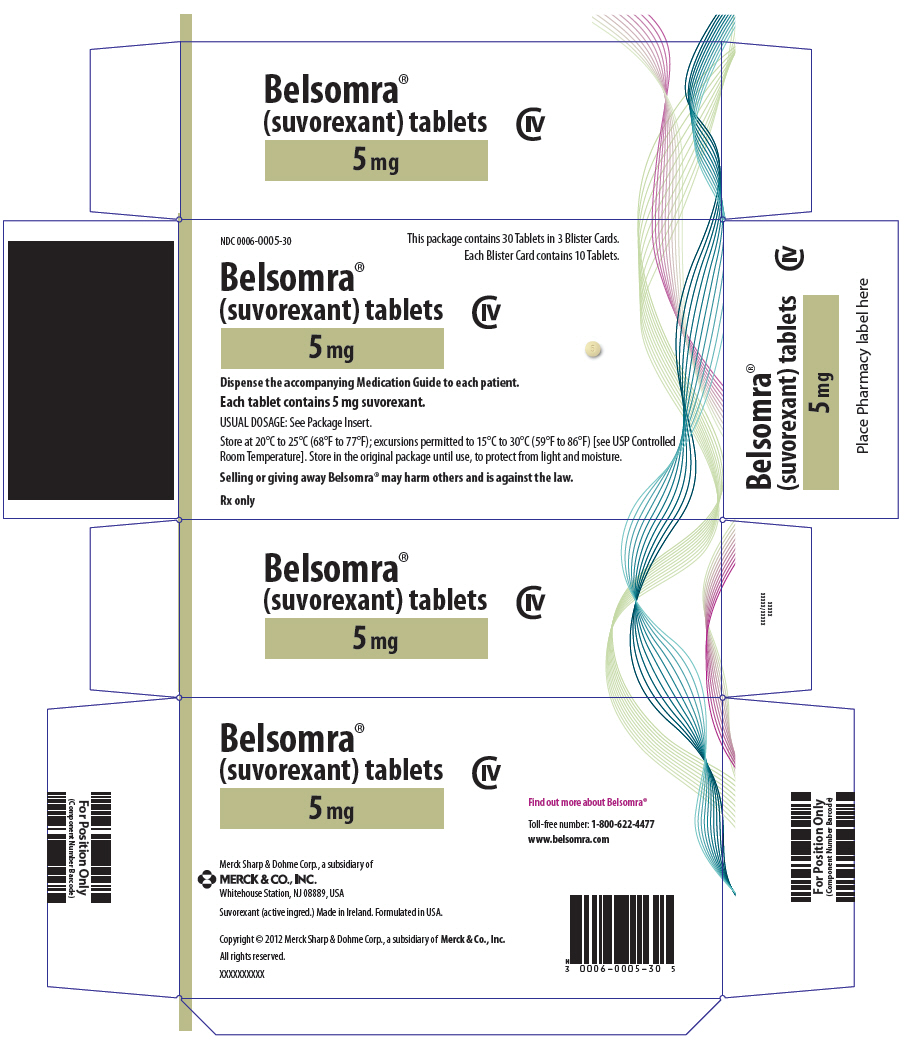
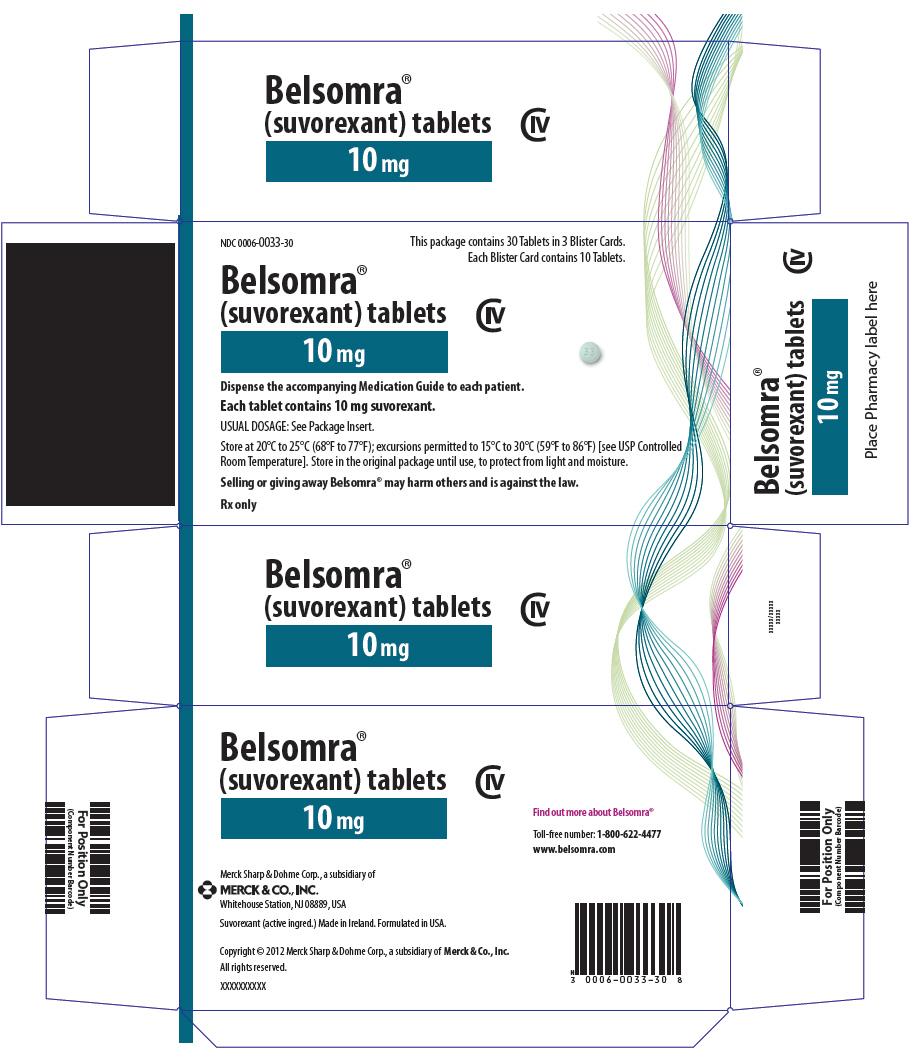
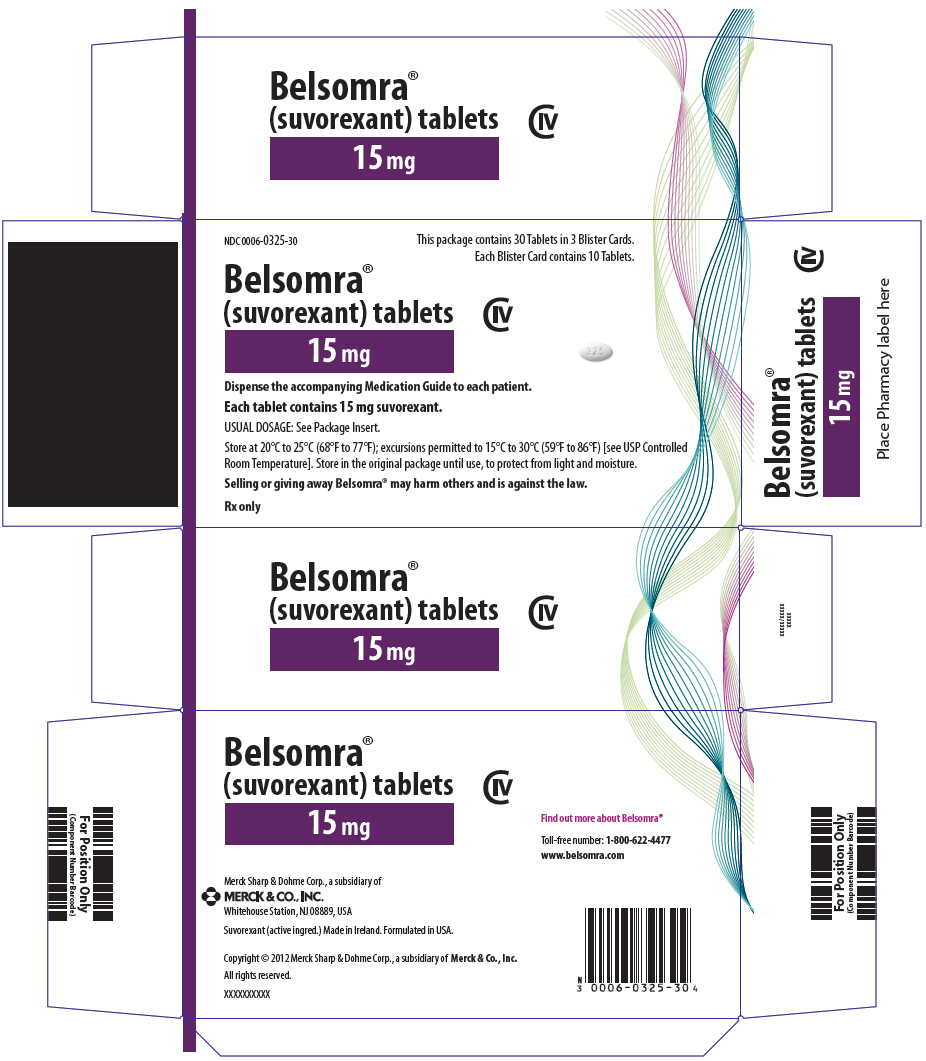
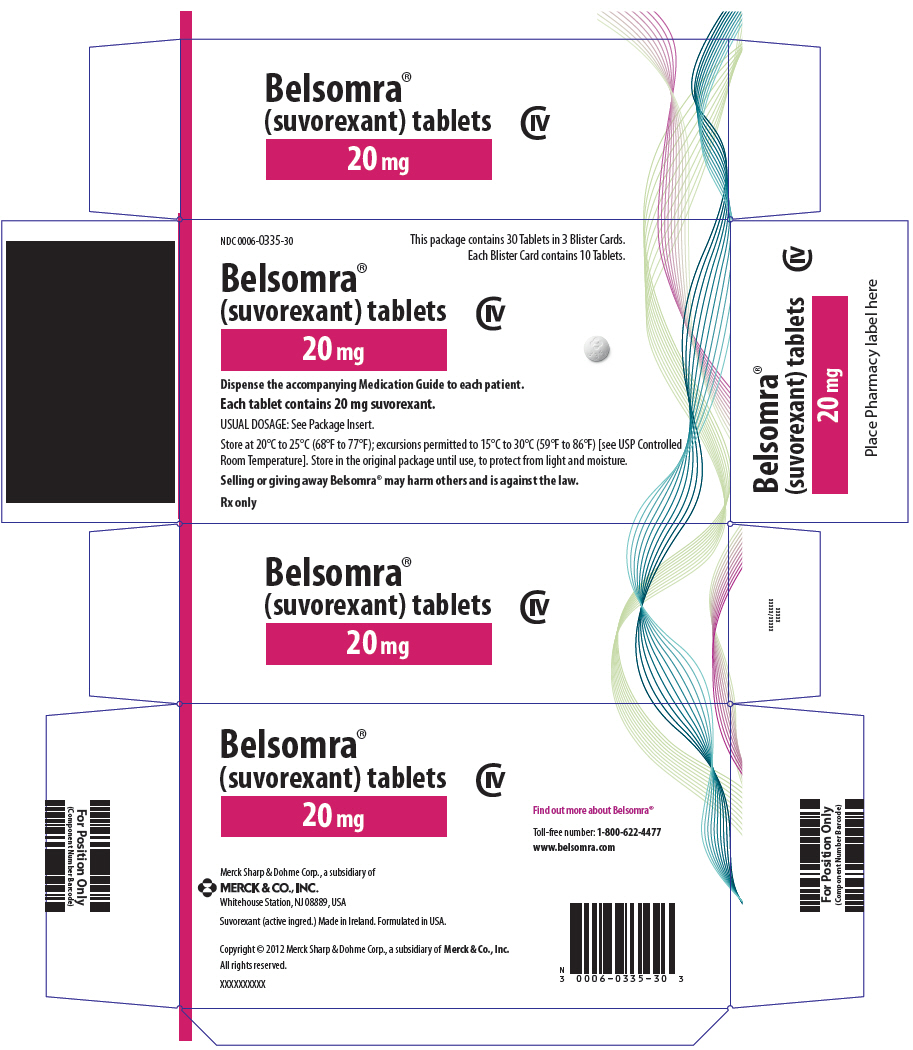
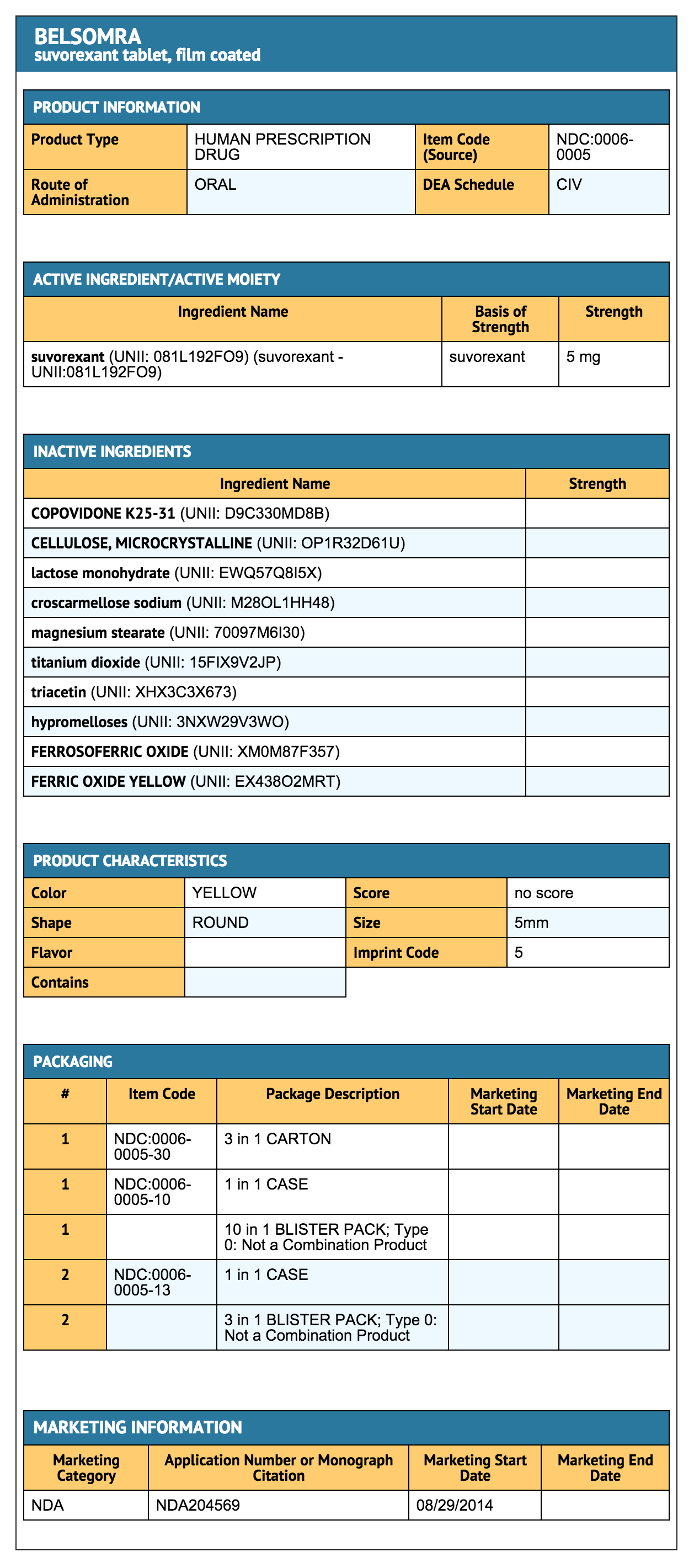
{{#ask: Label Page::Suvorexant |?Label Name |format=template |template=DrugLabelImages |mainlabel=- |sort=Label Page }}
Patient Counseling Information
- Advise the patient to read the FDA-approved patient labeling (Medication Guide).
- Inform patients of the availability of a Medication Guide and instruct them to read the Medication Guide prior to initiating treatment and with each prescription refill. Review the suvorexant Medication Guide with every patient prior to initiation of treatment.
CNS Depressant Effects and Next-Day Impairment
- Tell patients that suvorexant has the potential to cause next-day impairment, and that this risk is increased with higher doses or if dosing instructions are not carefully followed. Patients using the 20 mg dose should be cautioned against next-day driving and other activities requiring full mental alertness as this dose is associated with a higher risk of impaired driving. Patients taking lower doses should also be cautioned about the potential for driving impairment because there is individual variation in sensitivity to suvorexant.
- Patients should not drive or engage in other activities requiring full alertness within 8 hours of dosing of suvorexant.
Sleep-driving and Other Complex Behaviors
- Instruct patients to inform their families that suvorexant has been associated with getting out of bed while not being fully awake, and tell patients and their families to call their healthcare providers if this occurs.
- Hypnotics, like suvorexant, have been associated with "sleep-driving" and other complex behaviors while not being fully awake (preparing and eating food, making phone calls, or having sex). Tell patients and their families to call their healthcare providers if they develop any of these symptoms.
Suicide
- Tell patients to report any worsening of depression or suicidal thoughts immediately.
Alcohol and Other Drugs
- Ask patients about alcohol consumption, prescription medicines they are taking, and drugs they may be taking without a prescription. Advise patients not to use suvorexant if they drank alcohol that evening or before bed.
Tolerance, Abuse, and Dependence
- Tell patients not to increase the dose of suvorexant on their own, and to inform you if they believe the drug "does not work."
Administration Instructions
- Advise patients to take suvorexant only when preparing for or getting into bed and only if they can stay in bed for a full night before being active again. Advise patients to report all of their prescription and nonprescription medicines, vitamins and herbal supplements to the prescriber.
Precautions with Alcohol
- Alcohol-Suvorexant interaction has not been established. Talk to your doctor about the effects of taking alcohol with this medication.
Brand Names
- BELSOMRA®[1]
Look-Alike Drug Names
- There is limited information regarding Look-Alike Drug Names.
Drug Shortage Status
Price
References
The contents of this FDA label are provided by the National Library of Medicine.